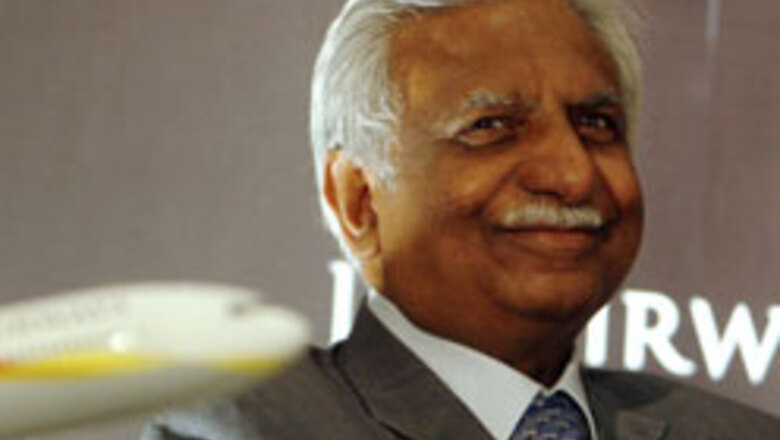
views
Since May 8 this year, a curious new bird has been flying in Indian skies. Maverick businessman Naresh Goyal has sprung a surprise by launching a new low-fare flying service, Jet Airways Konnect, by taking away half the number of flights from his flagship brand, Jet Airways. And he has done something normally unthinkable — he has ripped out the business class and replaced it with economy class seats. Then, in a complete break with his business philosophy, he made Jet Konnect a low-cost carrier (LCC), setting prices that compete with the likes of SpiceJet and Indigo.
Two months ago it didn’t exist, but today, Jet Konnect is becoming an important part of Jet’s strategy to ride out the slowdown in air travel, and could soon begin to overshadow the mother brand in number of flights. The fledgling airline, which started with 54 flights a week, has now raised the number to 125. It plans to go up to 160 flights in a few months. Compare that with the 110 that Jet Airways flies.
Why should Goyal, who has scant respect for the low-cost model despite running Jet Lite as an LCC, strip the airline of the lucrative J Class seats and then set up seats that fetch much lower returns? For instance, a passenger flying on Delhi-Mumbai, the busiest air-corridor in the country, pays about Rs 20,000 for a business class ticket while the economy traveller pays only about Rs 4,000. Of course, the fares are dynamic and the airlines keep coming up with new schemes and discount to nudge sales, but the differential between the classes is about 5:1. So whatever happened to Goyal’s belief in extracting premium fares from the high-fliers?
The answer, in one word, is pragmatism. Given a choice, Goyal would not have opted for this new model. But since September last year, when the downturn had begun to wreck havoc on air travel, his hand has been forced gradually. More and more seats were flying empty. By January, things began to look really bad. Load factors, industry jargon for capacity utilisation, fell sharply from about 75 percent to 55 percent, well below the breakeven level of about 70-75 percent.
While some pundits might have expected LCCs to suffer more in a downturn, reality turned out to be different. With a lower cost base and lower fares, LCCs have been able to face the downturn much more efficiently than the full-service airlines. “Passengers were saying that they weren’t prepared to pay for what Jet had on offer,” says Sudheer Raghavan, Jet’s chief commercial officer. “They were clearly looking for lower fare, no-frills service.” This reflected in the financial numbers. Jet’s losses touched Rs 455 crore in the nine months ended December 2008. The writing on the wall was clear. Jet no longer had the option to sit out the storm. It has to come up with a plan to make the best of the bad times.
Actually, ripping out the business class was not the first option that Goyal’s team tried. Since they already had a low cost brand JetLite, they initially tried a hybrid approach, using both airlines on some flights. That is, a passenger headed to city hub would be ferried by Jet while for the second leg of his travel (to a smaller place), he would have to board JetLite. The combined fare for the passenger would be lower. The plan obviously made sense, but somehow the dissonance was significant. “The hybrid experiment did not work. The cost did not come down sharply. And it ran the risk of cannabilising JetLite’s loyal customers,” recalls Raghavan. The LCC, bought out from Sahara India in 2007, is finally on a turnaround mode and has been turning in profits for the past two months, he says.
Goyal considered other options including moving some of the Jet Airways fleet to JetLite. The trouble, however, was that transferring the aircraft leases to the subsidiary company was not only time-consuming but would also need the regulator’s clearance.
Given the extent of erosion in air travel numbers, just using JetLite to benefit from the low-cost model was not enough. Goyal needed a low-cost breakthrough in the full-service side of his business. That’s when he decided to palm off Jet’s flights to all non-metro cities as well as the non-peak-hour flights on main sectors to Jet Konnect. To attract low-fare customers, he decided to do away with the business class seats on these flights. Business class seats are wider and deeper than economy class seats.
Typically a Boeing 737-800, the mainstay of Jet’s fleet, has 24 business class seats and 120 in economy. With Konnect, such planes were changed to accommodate 175 economy seats. It “wasn’t a decision to be made lightly,” says Raghavan.
To start with, Jet shifted six ATRs and two Boeing 737s, which were already all-economy, to the new brand. And almost instantaneously, Goyal’s team knew they had a winner. The market began to respond as if it had been waiting for it. The patronage came not just from individual fliers. Even corporate customers, who had their own cost-saving to implement, had begun to shop for lower fares, says Raj Sivakumar, Jet’s vice president for revenue management.
PAGE_BREAK
Jet Konnect, with 40 percent lower fares, attracted them all. Passenger load increased to 75 percent. This, by no means, was the best scenario possible. As loads went up, the average price that Jet earned per air mile fell by 12-14 percent. But at least, the airline wasn’t losing passengers to rival LCCs. This response has enabled Jet Konnect to expand beyond the non-metro routes into the busy metro segments, where it operates side by side with Jet Airways.
Over the years, business class passengers have been pampered more and more. Jitender Bhargava, director of public relations at Air India, says that the frills increased over the years. On a typical domestic flight on Air India, the national carrier offers its Club class passengers a choice of at least three meal options, better cutlery, linen and an option of two or three fruit juices. The crew to passenger ratio too is higher. While two crew members typically serve the 20-odd seater business class, the 115-odd in the economy class have only four crew members attending to them.
This is where Jet expects to gain by shifting to the new model. With Jet Konnect, Goyal is banking on lower cost of service. Passengers have to buy their own meals, which brings in an extra bit of revenue. Jet’s frequent fliers can still earn miles on the new airline, but they don’t enjoy access to airport lounges as of now.
Contrast this with the strategy that Vijay Mallya has followed with Kingfisher and Kingfisher Red. He doesn’t want to climb down from the image of running a five-star airline and serves snacks on Red. He operates more Red flights than full-service ones, but has not been able to make the crossover to a low-fare model that is probably the only way to lower his costs. On this count, While both Goyal and Mallya have to contend with huge losses, the former may have his nose ahead in trying to emerge out of it.
The third carrier, Indian, is slower still. One part of the restructuring strategy is to extend Air-India Express services to domestic routes. But the plan is yet to get off the drawing board. Meanwhile, Indian is trying to increase load factors on business class with buy-one-get-one-free offers, special lower fares.
Not everyone is sure that Goyal’s game plan will work. Full service airlines trying out the low cost game have almost invariably failed. Aviation industry observer Perry Flint thinks that a full service airline cannot compete with LCCs simply by removing business class seats and stopping meal service. “At least no one has done it successfully without also reducing other costs, most importantly, labour costs,” says Flint, editorial director and associate publisher of US-based Air Transport World magazine. The airline will surely lose less money than it did flying only half-full. But unless it can lower its costs, it will be a hard time returning to profit, he adds.
Almost every full service airline, be it British Airways’ Go or United Airlines’ Ted, has tried its hand at setting up a low cost model. Though the LCC recipe for success is well known, few full service airlines have been able to replicate it.
In Jet’s case, Jet Konnect is not even a separate company. It has the same backend as Jet in terms of staff and support. The culture to drive a low cost carrier hasn’t taken root.
So how will Goyal achieve this balancing act? Raghavan is clear that his boss isn’t giving up his obsession with value-added service. And that this tactical maneuver won’t last forever. “Our DNA is that of a premium, full service carrier, and we will put the seats back as soon as we see a revival,” he says. For the moment though, Jet Konnect is his only chance of seeing some green shoots near the tarmac.
















Comments
0 comment